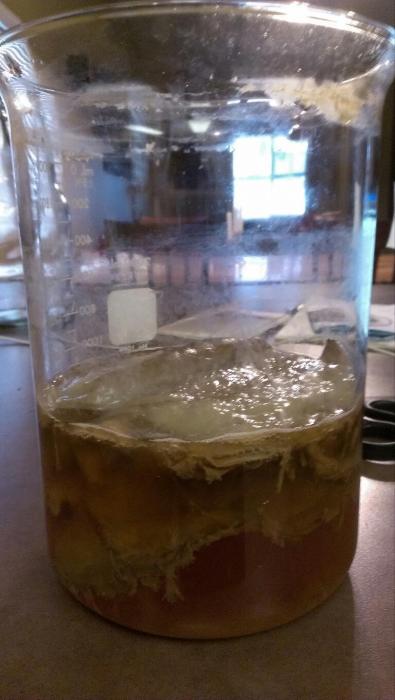I ended up pouring most of the liquid into my bottles for finishing up, and left the whole thing in the beaker with enough liquid to cover. With the pouring (tilting the beaker back and forth a few times) I'm thinking the bacteria got stirred up enough to be distributed well.
Probably not, when you slowly pour from a beaker, you're decanting. Pouring from the top first, and the bottom last. Unless you were REALLY pouring it all or a lot at once. Still, I wouldn't worry about it unless you notice the batches aren't souring as quickly as they used to.
In the future, are you saying I could just pull a sample out of a brew near the end of fermentation and use that to innoculate a new batch? I haven't read the link you provided yet so forgive me if this is answered there. In terms of microbiology it seems like any amount of (balanced) yeast and bacteria will re-multiply in a new medium, right?
Yes, and yes. You can draw a sample and put it in new tea, with no scoby, and it will ferment and produce a new scoby. If the liquid is balanced, the microbes should repopulate as expected. Just like repitching yeast when making beer.
Like I said, I'll probably quickly move to a continuous brew and just draw off and replace some portion of the brew every few days. Still figuring out the best way to go about that as far as how much to take and how much to leave.
This is completely a personal preference. Some people choose to fill several containers and drink on that while they wait for a larger volume of new tea to ferment. Others like to replace as they go. What you wouldn't want to do is take a lot, replace it and drink it right away. Unless you prefer it still somewhat green and sweet.
It is my personal preference not to ever take more than 2/3 of the total batch volume. Nature loves thirds it seems. This allows me to harvest every quarter moon phase (7-8 days). I could take more, but it would require a longer ferment time, and I'm somewhat impatient, so this works for me. It may not work out for you. If you tend to forget you had things fermenting, you wouldn't want to use more starter, you'll end up with vinegar faster. Conversely, if you really hate waiting, you may opt to take smaller volumes, so it's done sooner.
I have no empirical evidence demonstrating this, just a guess, thinking outloud if you will, if I removed only 1/3 total volume, I would still expect it to only shave a few days off of my 7. 1L of starter for 3L total volume is ready in 7 days; 2L of starter for 3L total volume, I'd expect ready in ~5.
24-48hrs lag time-ish, maybe a day to actually ferment, then another day for the acetobacter to do their thing.
I ran a test batch with champagne yeast once, the tea was dry in 4-5 days, but acetobacter just couldn't keep up. I ran another test batch where I added 50ml of plain vodka to primary at day 0, and it turned to vinegar really fast but was still sweet! Both of those were a no go for our tastes. I did, however, discover how to make kombucha vinegar in short order! lol
Get a notebook, take some measurements over time and taste tests. Let us know what you find works best for you!
To the Science! :rockin:




